You want to engage your website visitors, so you added a chatbot to your pages.
Great choice!
Now comes the tricky part—training a chatbot to interact with your audience efficiently.
But how to do that and where to start?
Right here!
We’ll show you how to train chatbots to interact with visitors and increase customer satisfaction with your website.
First of all, it’s worth mentioning that advanced developers can train chatbots using sentiment analysis, Python coding language, and Named Entity Recognition (NER). Developers also use neural networks and machine learning libraries.
However, if you’re not a professional developer or a tech-savvy person, you might want to consider a different approach to training chatbots.
In this article, we’ll focus on how to train a chatbot using a platform that provides artificial intelligence (AI) and natural language processing (NLP) bots.
Okay.
Let’s look at essential terms—
Chatbot training: basic terms
There are hundreds of terms related to chatbots. But you probably won’t need to know them all. So, instead, let’s focus on the most important terminology related specifically to chatbot training.
It would be useful for you to familiarize yourself with terms such as:
- Chatbot training—the process of inputting data into a chatbot so that it understands and responds appropriately to the users’ questions
- Intent—the intention or purpose behind the user’s question
- Utterance—different ways a user could phrase a question
- Entity—a keyword that specifies the intent of the user
- Trigger—the rule that triggers the chatbot into action
- Condition—the circumstances that need to be fulfilled for the bot to trigger
- Action—the act that the chatbot performs
Now—the important question.
How to train a chatbot?
You can develop and train chatbots with code. But that would take a long time and effort. It’s worth noting that different chatbot frameworks have a variety of automation, tools, and panels for training your chatbot. But if you’re not tech-savvy or just don’t know anything about code, then the best option for you is to use a chatbot platform that offers AI and NLP technology.
Now—
You have the background for how to train AI. But keep in mind that chatbot training is mostly about predicting user intents and the utterances visitors could use when communicating with the bot.
So, let’s discover how to train a chatbot using a bot platform. Here are some tips on what to pay attention to when implementing bots and training them.
1. Determine the chatbot use cases
Don’t just make a wish list of what you’d like the bot to do. Have some data backing it up instead.
What do your customers want from your virtual assistant? And what does your business need the conversational AI for?
You might want the chatbot to generate leads, but what your shoppers want is to check their order status. In fact, our study shows that buyers would prefer to use a chatbot mostly for checking their order status (71%) and searching for products (67%).
Some platforms, like Tidio, come with a pre-trained AI engine that recognizes common intents. This makes bot training much faster and easier for you.
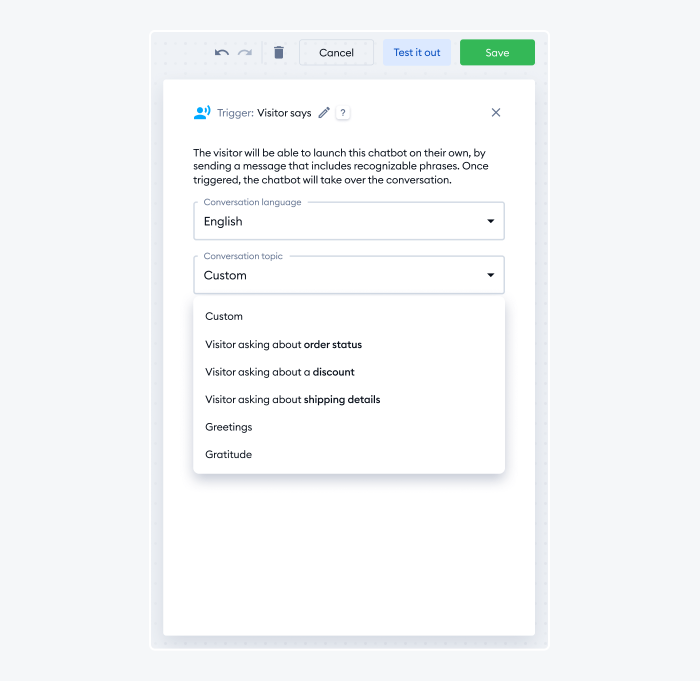
2. Define the user intent
Why is the visitor asking the question? What’s the intention and desired outcome behind their query?
You need to understand what the visitor wants first. So, create very specific chatbot intents that serve a defined purpose and give relevant information to the user when training your chatbot. For example, you could create chatbots for customers who are looking for your opening hours, searching for products, and looking for order status updates.

Don’t try to mix and match the user intents as the customer experience will deteriorate. Instead, create separate bots for each intent to make sure their inquiry is answered in the best way possible.
Did you know that …
A study shows that three of the most common customer frustrations include lack of effectiveness (27% of customers), lack of speed (12%), and lack of accuracy (10%.)
Set up and train your chatbot in less than 5 minutes to improve your customer serv
3. Analyze your conversation history
The easiest way to collect and analyze conversations with your clients is to use live chat. Implement it for a few weeks and discover the common problems that your conversational AI can solve.
These include repetitive questions, tasks, and onboarding FAQs. It’s easier to decide what to use the chatbot for when you have a dashboard with data in front of you.
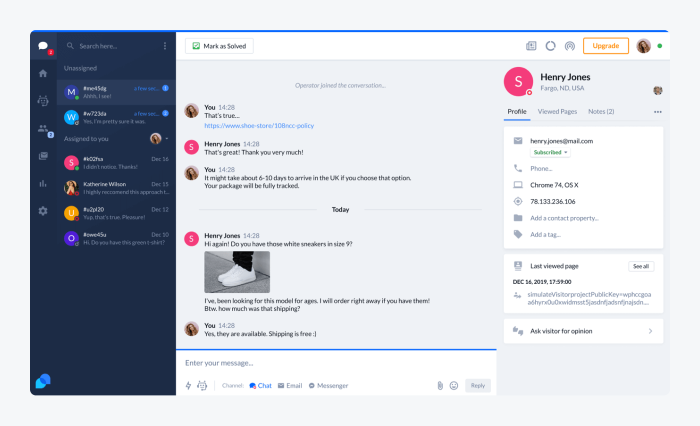
So, once you added live chat software to your website and your support team had some conversations with clients, you can analyze the conversation history. This will help you find the common user queries and identify real-world areas that could be automated with deep learning bots.
And the easiest way to analyze the chat history for common queries is to download your conversation history and insert it into a text analysis engine, like the Voyant tool. This software will analyze the text and present the most repetitive questions for you.
If you want to develop your own natural language processing (NLP) bots from scratch, you can use some free chatbot training datasets. Some of the best machine learning datasets for chatbot training include Ubuntu, Twitter library, and ConvAI3.
4. Generate variations of the user query
There are tens of different ways to phrase a question. The intent is the same, but the way your visitors ask questions differs from one person to the next.
Think about it—a simple “how are you?” question can be asked in so many different ways.

The same happens when your website visitors are asking a question. Users can phrase their inquiry in a variety of different ways. So, you need to prepare your chatbot to respond appropriately to each and every one of their questions.
Pro-tip
When developing your AI chatbot, use as many different expressions as you can think of to represent each intent. The user-friendliness and customer satisfaction will depend on how well your bot can understand natural language.
5. Ensure that keywords match the intent
When you’re done writing all the utterances that come to your mind, look for the words that represent the key information of the query. These are your entities, and they extract the vital information to tag in an utterance.
Now, let’s go back to our example about the opening hours. What do you think the keyword in this inquiry is?

That’s right!
The keyword is the main part of the inquiry that lets the chatbot know what the user is asking about. So, in the case of “what are your opening hours”, the keywords will be “open” and “hours”.
So—how to “feed” the chatbot with data so it recognizes the queries correctly?
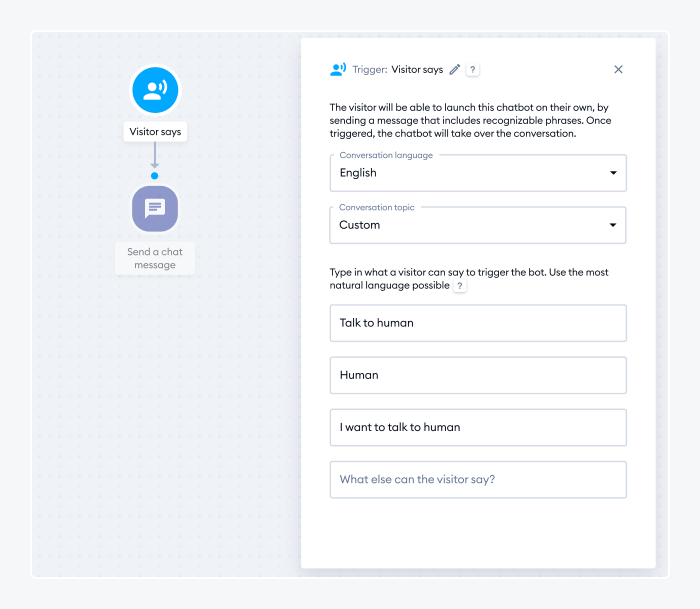
To train your AI, add an NLP trigger to your chatbot. You can add words, questions, and phrases related to the intent of the user. The more phrases and words you add, the better trained the bot will be.
Did you know that…
Machine learning algorithms of popular chatbot solutions can detect keywords and recognize contexts in which they are used. They use statistical models to predict the intent behind each query. The word “business” used next to “hours” will be interpreted and recognized as “opening hours” thanks to NLP technology.
6. Teach your team members how to train bots
Your customer support team needs to know how to train a chatbot as well as you do. The reason is that you already have so much on your plate. You shouldn’t take the whole process of training bots on yourself as well. Your support team members are there to help you out.

You may find that your live chat agents notice that they’re using the same canned responses or live chat scripts to answer similar questions. This could be a sign that you should train your bot to send automated responses on its own. Also, brainstorm different intents and utterances, and test the bot’s functionality together with your team.
Another reason for working on the bot testing and training as a team is that a single person might miss something important that a group of people will spot easily.
7. Give your chatbot a personality
Find the right tone of voice, give your chatbot a name, and a personality that matches your brand. Using a bot gives you a good opportunity to connect with your website visitors and turn them into customers. So, your chatbot should reflect your business as much as possible.
Look at the tone of voice your website and agents use when communicating with shoppers. Then mirror that onto your bot. And while training a chatbot, keep in mind that, according to our chatbot personality research, most buyers (53%) like the brands that use quick-witted replies instead of robotic responses.

Add links to your knowledge base to your FAQ chatbots’ answers. This will make it easier for learners to find relevant information and full tutorials on how to use your products.
8. Add media and GIFs
You can add media elements when training chatbots to better engage your website visitors when they interact with your bots. Insert GIFs, images, videos, buttons, cards, or anything else that would make the user experience more fun and interactive.
After all, when customers enjoy their time on a website, they tend to buy more and refer friends.
So, providing a good experience for your customers at all times can bring your business many advantages over your competitors. In fact, over 72% of shoppers tell their friends and family about a positive experience with a company.
Read more: Discover how a small home decor store used chatbots to compete on the market with IKEA.
9. Revise the chatbots and improve them regularly
Chatbot training isn’t a set-it-and-forget-it kind of task.
It’s an ongoing process.
Once you train and deploy your chatbots, you should continuously look at chatbot analytics and their performance data. This will help you make informed improvements to the bot’s functionality. Sometimes you just need to train your chatbot a little more. Other times, you’ll need to change the approach to the query for the best results.
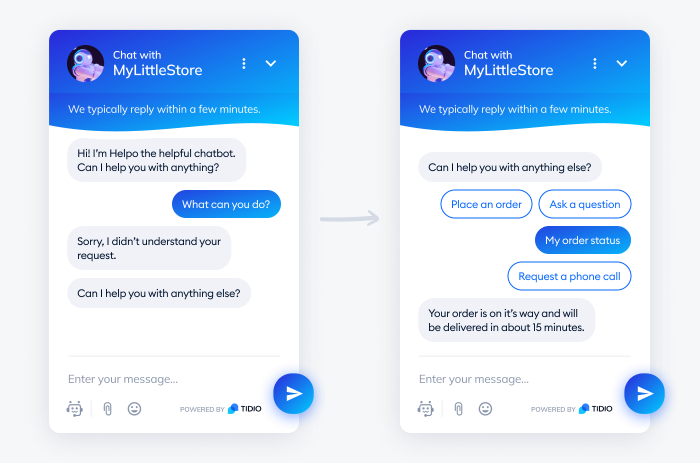
And always remember that whenever a new intent appears, you’ll need to do additional chatbot training. Don’t try to add the intent to your existing bots.
Once you trained chatbots, add them to your business’s social media and messaging channels. This way you can reach your audience on Facebook Messenger, WhatsApp, and via SMS. And many platforms provide a shared inbox to keep all of your customer communications organized in one place.
Chatbot training example
You know the basics and what to think about when training chatbots. But how to actually train a bot using a chatbot platform? Let’s go through it step by step, so you can do it for yourself quickly and easily.
We’ll be using Tidio for this guide.
Step #1 Go to the Chatbot tab
First of all, register for the free forever account with Tidio. It doesn’t require any card details or commitments from your side. You can also use it for free for as long as you want.
So, once you’ve registered for an account and customized your chat widget, you’ll get to the Tidio panel. Now, go to the Chatbot tab by clicking on the chatbot icon on the left-hand side of the screen.
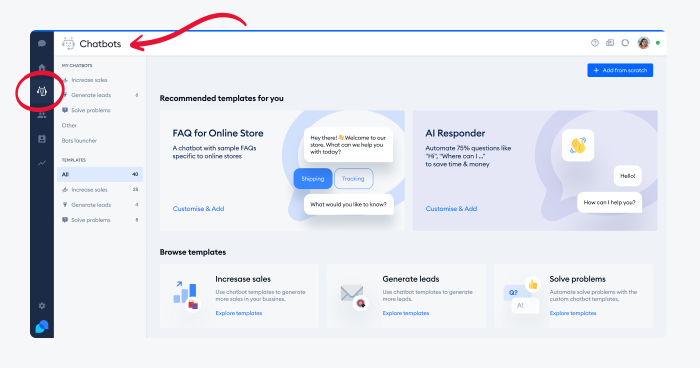
This is the page where you can train an AI chatbot from scratch. You can also use one of the templates to customize and train bots by inputting your data into it.
Read more: Learn how to edit the initial chatbot message with Tidio.
Step #2 Launch the chatbot builder
You can choose to add a new chatbot or use one of the existing templates.
If you decide to create a chatbot from scratch, then press the Add from Scratch button. It lets you choose all the triggers, conditions, and actions to train your bot from the ground up.

You can also scroll down a little and find over 40 chatbot templates to have some background of the bot done for you. If you choose one of the templates, you’ll have a trigger and actions already preset. This way, you only need to customize the existing flow for your needs instead of training the chatbot from scratch.
We’ll be going with chatbot training through an AI Responder template. So, for practice, choose the AI Responder and click on the Use template button.
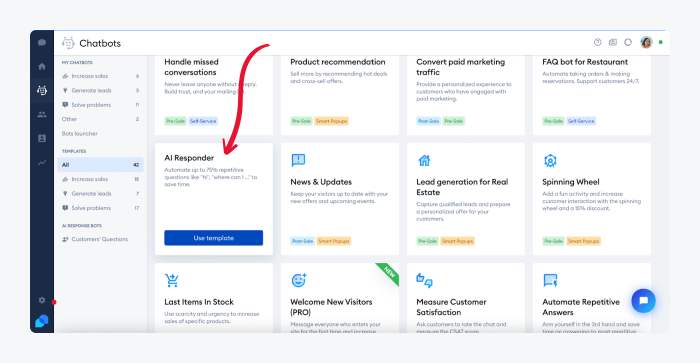
A screen will pop up asking if you want to use the template or test it out. Click Use template to customize it and train the bot to your business needs.

Step #3 Customize what the visitor could say
Now, click on the Visitor says trigger. This is where you write down all the variations of the user’s inquiry that come to your mind. Decide what the intent is and type different utterances. These will include varied words, questions, and phrases related to the topic of the query. The more utterances you come up with, the better for your chatbot training.
We’ll go with our previous example of opening hours to show you how it works.

You can also change the language, conversation type, or module for your bot. There are 16 languages and the five most common conversation types you can pick from. If you’re creating a bot for a different conversation type than the one listed, then choose Custom from the dropdown menu.
Labeling chatbots to match the user intent is good practice. This way, you’ll create multiple conversation designs and save them as separate chatbots.
Step #4 Type up the bot’s response
You have the inquiry and different ways of asking about it. Now, it’s time to think of the best and most natural way to answer the question.
So, click on the Send a chat message action button and customize the text you want to send to your visitor in response to their inquiry.
In the case of the question for opening hours, this message could look like this:
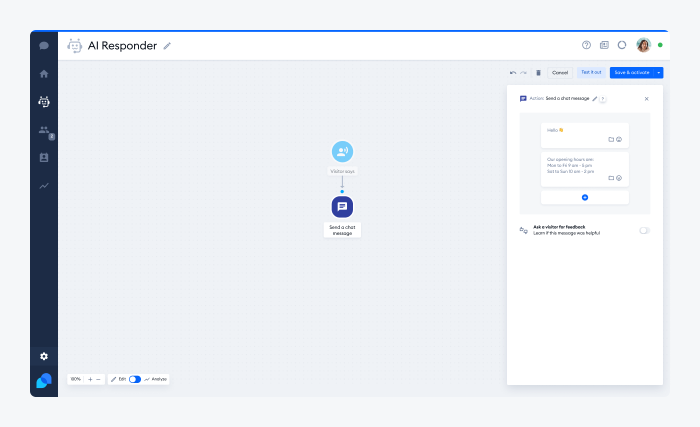
Step #5 Add additional conditions and actions
You can add any additional information conditions and actions for your chatbot to perform after sending the message to your visitor.

To do so, click on the action or condition button and choose the right one for your needs.
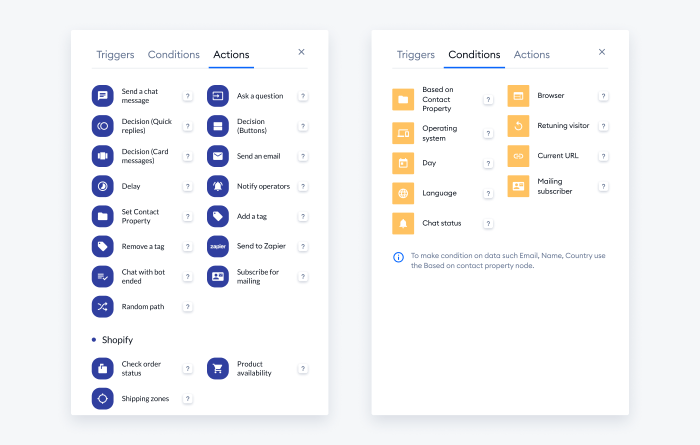
Add as many actions and conditions as you like, but remember not to make the chatbot too complex. It needs to serve a specific purpose and user intent. So, try not to make it too general or serve multiple intents with one bot, as it will confuse the user instead of being helpful. The balance is key!
Step #6 Ask the visitor for feedback
Check if the response you gave the visitor was helpful and collect some feedback from them. The easiest way to do this is by clicking the Ask a visitor for feedback button. This will automatically ask the user if the message was helpful straight after answering the query.
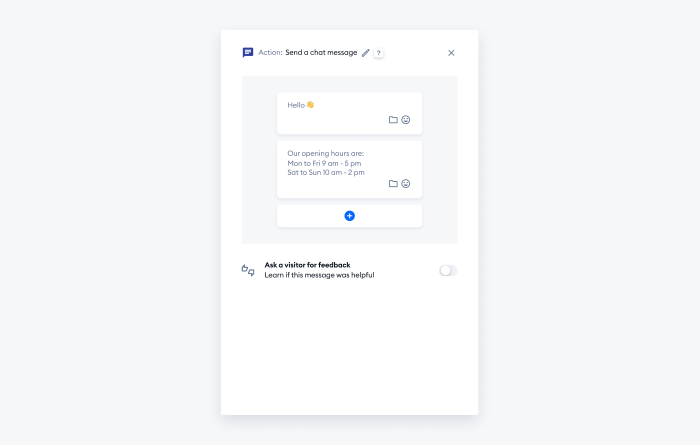
Once you’re happy with the trained chatbot, you should first test it out to see if the bot works the way you want it to. If it does, then save and activate your bot, so it starts to interact with your visitors.
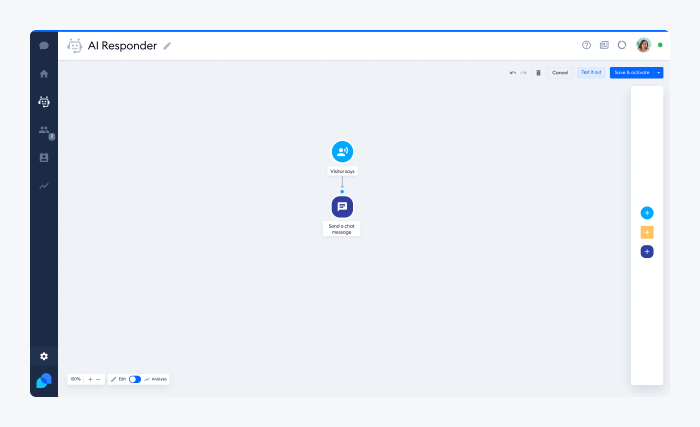
And you’re good to go!
Key takeaway
As a recap—
Chatbot training is the process of adding data into the chatbot in order for the bot to understand and respond to the user’s queries.
You can train a bot in a few simple steps. These include:
- Deciding on the chatbot use
- Defining the user intent
- Picking the most common customer inquiries
- Typing the utterances
- Checking the keywords
- Brainstorming intents and utterances with colleagues
- Personalizing the chatbot
- Adding images and other media
- Constantly improving the chatbot
Keep in mind that training chatbots requires a lot of time and effort if you want to code them. The easier and faster way to train bots is to use a chatbot provider and customize the software.
Train your own AI to engage with your website visitors on autopilot

